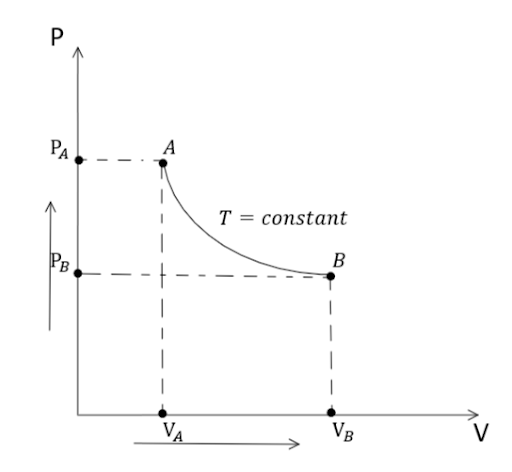
For an ideal gas, in an isothermal process
A. Heat content remains constant
B. Heat content and temperature remains constant
C. Temperature remains constant
D. None of the above
Answer
219k+ views
Hint: In this problem, to determine which option is correct for an isothermal thermodynamic process, we must know the basic fundamentals and applications of an isothermal process following the condition $\Delta T = 0$ hence, use this condition to state the answer for the given situation with proper explanation.
Complete step by step solution:
The term "isothermal process" refers to a substance, an item, or a system changing at a specific constant temperature. Isothermal Process in thermodynamics is a process during which the temperature $T$ of a system remains constant whereas other variables like pressure $P$ and volume $V$ may change that’s why it is also referred to as a constant-temperature process.
In the Isothermal process, $\text{Change in Temperature} = \Delta T = 0$ or, $T{\text{ }} = \text{constant}$. Graphically, an isothermal process can be represented as: -

A thermodynamic process is known as an isothermal process when the system temperature is constant because heat is transferred into or out of the system so slowly, that thermal equilibrium is preserved.
If a system comes into contact with a thermal reservoir from the outside, it gradually modifies its own temperature through heat exchange to preserve thermal equilibrium which means heat content is not constant as a result of which options (A) and (B) become incorrect. Thus, in an isothermal process, the temperature remains constant for an ideal gas.
Hence, the correct option is C.
Note: In this case, we know that temperature varies with the given conditions of the system and surroundings. But to keep the system’s temperature constant, either the heat is drawn into the system from the surroundings or it is taken from the system and discharged outside to the surroundings. Additionally, the heat pump is one of the illustrations of an isothermal process.
Complete step by step solution:
The term "isothermal process" refers to a substance, an item, or a system changing at a specific constant temperature. Isothermal Process in thermodynamics is a process during which the temperature $T$ of a system remains constant whereas other variables like pressure $P$ and volume $V$ may change that’s why it is also referred to as a constant-temperature process.
In the Isothermal process, $\text{Change in Temperature} = \Delta T = 0$ or, $T{\text{ }} = \text{constant}$. Graphically, an isothermal process can be represented as: -

A thermodynamic process is known as an isothermal process when the system temperature is constant because heat is transferred into or out of the system so slowly, that thermal equilibrium is preserved.
If a system comes into contact with a thermal reservoir from the outside, it gradually modifies its own temperature through heat exchange to preserve thermal equilibrium which means heat content is not constant as a result of which options (A) and (B) become incorrect. Thus, in an isothermal process, the temperature remains constant for an ideal gas.
Hence, the correct option is C.
Note: In this case, we know that temperature varies with the given conditions of the system and surroundings. But to keep the system’s temperature constant, either the heat is drawn into the system from the surroundings or it is taken from the system and discharged outside to the surroundings. Additionally, the heat pump is one of the illustrations of an isothermal process.
Recently Updated Pages
Two discs which are rotating about their respective class 11 physics JEE_Main

A ladder rests against a frictionless vertical wall class 11 physics JEE_Main

Two simple pendulums of lengths 1 m and 16 m respectively class 11 physics JEE_Main

The slopes of isothermal and adiabatic curves are related class 11 physics JEE_Main

A trolly falling freely on an inclined plane as shown class 11 physics JEE_Main

The masses M1 and M2M2 M1 are released from rest Using class 11 physics JEE_Main

Trending doubts
JEE Main 2026: Application Form Open, Exam Dates, Syllabus, Eligibility & Question Papers

Derivation of Equation of Trajectory Explained for Students

Hybridisation in Chemistry – Concept, Types & Applications

Understanding the Angle of Deviation in a Prism

Understanding Collisions: Types and Examples for Students

Understanding Atomic Structure for Beginners

Other Pages
JEE Advanced Marks vs Ranks 2025: Understanding Category-wise Qualifying Marks and Previous Year Cut-offs

Units And Measurements Class 11 Physics Chapter 1 CBSE Notes - 2025-26

NCERT Solutions For Class 11 Physics Chapter 8 Mechanical Properties Of Solids

Motion in a Straight Line Class 11 Physics Chapter 2 CBSE Notes - 2025-26

NCERT Solutions for Class 11 Physics Chapter 7 Gravitation 2025-26

How to Convert a Galvanometer into an Ammeter or Voltmeter




